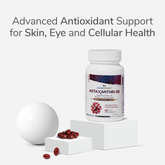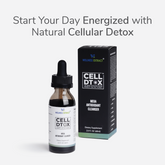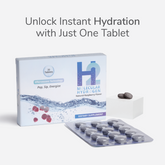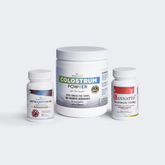Estimated Reading Time: 8 minutes
|You might have scrolled through bovine colostrum smoothie trends as the 'healthiest breakfast recipe' across all your Instagram feeds. However, do you know that it's not just cattle that produce colostrum milk but all mammals?
Then, why is it just bovine colostrum that is earning the spotlight as a 'nutritional secret' in the world of supplements? Even goats and sheep do produce colostrum. Are those really not as beneficial as the formula produced by bovines? Well, that's not the truth! In fact, sheep colostrum has a higher concentration of immunoglobulins(antibodies) compared to others. Then? Let's compare it with the scientific details!
Before Anything, Understand the Term 'Bovine'
You need to understand the term bovine first. What makes bovines different from other animals? Readers often confuse it with milk-producing animals or bovids. However, that's not the fact.
Not all milk-producing animals are bovine. Bovine is a Latin word related to cows and cattle. It also includes water buffaloes and other hybrids. On the other hand, Bovidae, also known as bovids, is a more general term that includes other animals, such as goats and sheep.
| Bovidae is a general classification that consists of 143 extant species and approximately 300 extinct species, including bovines. |
A Quick Recap About Colostrum
Though most of us know what colostrum is, here is a quick recap. Colostrum, called 'liquid gold' for a good reason, is the first milk mothers produce after giving birth. Scientists call colostrum a blessing for children as it is crucial for their early nutrition and development.
Most mammals produce thick yellowish colostrum that is creamier than the milk produced in the later stages. Packed with immunoglobulins and growth hormones, it builds passive immunity in newborns, protecting them from infections and chronic threats.
Due to its affordability and accessibility, bovine colostrum is a popular and nutrient-dense supplement for kids, athletes, and even pets. Click the linked blog to get detailed information on Bovine Colostrum and Its Health Benefits.
 Comparing Bovine Colostrum with Other Animal Colostrum
Comparing Bovine Colostrum with Other Animal Colostrum
Here comes the king section of the blog: a comparison of bovine colostrum with that of other animals.
The quality and quantity of colostrum depend on several factors, including species, feeding patterns, harvesting, and lactation cycles. However, it's the nutraceutical value that makes the real difference. The nutraceutical value determines the health advantages and therapeutic benefits of colostrum (especially as a human supplement). Going through different criteria will help you understand what makes bovine colostrum a trend.
The analysis is based on a scientific study that compares the composition and quality of colostrum from different animals.
-
Total Protein: The House of Antibodies
Protein is the main source of immunoglobulins that protect newborns from diseases and infections. Human colostrum has the lowest protein content. Therefore, doctors often recommend bovine colostrum supplements for babies and kids.
-
Bovine colostrum contains a higher protein content than humans and other animals (except sheep).
-
Sheep colostrum contains the highest amount of protein (6.3%), comprising 4.8% casein.
-
However, bovine colostrum contains 2.68% casein, compared to 0.5% in humans, suggesting better protection against infections.
-
Lactose: A Milk Carbohydrate
Lactose is important for gut bacteria and the immune system. It also affects the milk volume and the concentration of proteins, such as casein. Human colostrum contains approximately 7% lactose, which is significantly higher than in other animals.
-
Bovine colostrum contains 4.8% lactose, which is lower than in humans but still the highest among animals.
-
Sheep and goat colostrum contain much lower lactose. Therefore, for lactose-intolerant individuals, sheep or goat colostrum is the best!
-
Minerals: The Immune Protectors
Among newborns and growing children, minerals are a crucial source of development and nutrition. Minerals such as magnesium, zinc, and iron support immune health and contribute to bone strength. Compared to animals, human colostrum contains very few minerals (just 0.21%).
-
Bovine colostrum contains a good amount of minerals (0.71%). It is far superior to humans and comparable to goats (0.77%)
-
Sheep colostrum contains the highest percentage of iron, which increases even further over time.
-
Bovine colostrum has the highest zinc composition among animals (15.56%), which supports wound healing, the immune system, and nourishes skin radiance. It is also a significant source of other minerals like manganese, iron, and copper.
-
On the other hand, goat's first milk is rich in iron, selenium, and antioxidants, such as tocopherols. And do you know what? Due to its high selenium content, goat milk is often used for medicinal purposes (especially for dengue).
-
Lipids and Fats: Key to Energy
Lipids in colostrum support energy production and basic metabolism. They are also important for overall health and development, particularly in the growing stages. However, an excess of lipid composition may result in digestive issues, especially in human infants.
-
The total lipid levels in bovine colostrum are comparable to humans, showing its digestive safety (even for infants).
-
Sheep colostrum has the highest lipid content, followed by goat colostrum.
-
Dry Matter: Define Concentrated Nutrients
Higher dry matter in colostrum indicates a more concentrated level of essential nutrients, including proteins, antibodies, and minerals. In simple comparison, the higher the dry matter, the better the immune system and development.
-
Sheep colostrum is richest in dry matter, showing it is nutritionally dense and potent.
-
Bovine colostrum contains 12.8% of dry matter, which is better than humans and almost the same as goats. It is also a rich source of lactoferrin, an iron-binding protein that promotes overall wellness among newborns.
-
Quantity: Decides the Practical Applications
The amount of colostrum produced by animals plays a crucial role in determining its medical and commercial applications. To keep it accessible and affordable for humankind, it is best to choose a source that strikes a balance between quantity and quality.
-
A healthy dairy bovine can produce approximately 3.8 to 7.7 kilograms of colostrum at first calving, containing a high number of antibodies.
-
Furthermore, the composition varies significantly according to breed and genetics. For example, among cows, Jersey cows produce colostrum with higher IgG concentrations compared to others.
-
Sheep produce just 1.2-4.5 kg of colostrum in the 48 hours after lambing. Therefore, it is much more expensive and less accessible in non-hilly terrains.
-
Even in goats, the quantity of colostrum is sometimes low, at just 120 g in the first 10 hours after kidding.
-
The amount of colostrum in animals also depends on the lactation cycle. Studies show that cows in their 4th lactation cycle produced the highest quality and quantity of colostrum.
-
As the time after parturition increases, the quality and quantity of colostrum begin to decrease among mammals. Reasons? The breast milk starts to develop into transitional milk, followed by mature milk.
Tabular Comparison Between Bovine Vs. Sheep Vs. Goat Colostrum
The table below compares bovine colostrum with sheep and goat colostrum in brief. Go through the details to make an informed decision:
|
Comparison Factor |
Bovine (Mainly Cow) |
Sheep |
Goat |
|
Total Protein (%) |
3.3 |
6.35 |
3.4 |
|
Casein (%) |
2.68 |
4.82 |
1.94 |
|
Lactose (%) |
4.8 |
3.23 |
4.7 |
|
Total Lipids (%) |
3.8 |
8.21 |
4.1 |
|
Ash (Minerals) (%) |
0.71 |
0.59 |
0.77 |
|
Dry Matter (%) |
12.8 |
24.58 |
13.0 |
|
Copper (Cu) (%) |
2.34 |
1.42 |
1.98 |
|
Zinc (Zn) (%) |
15.56 |
9.57 |
7.05 |
|
Manganese (Mn) (%) |
5.59 |
6.33 |
4.72 |
|
Iron (Fe) (%) |
1.95 |
5.47 |
2.99 |
|
Quantity (24 hours) |
4.6 to 7.9 kilograms |
Approximately 10% of their body weight |
Approximately 10% of their body weight |

From the above table, you can observe the fact that sheep colostrum has the highest proteins, immunoglobulins, and dry matter percentage. In other words, it is best for building immunity. However, due to the low quantity and the limited habitats of dairy sheep, it isn't readily available or affordable.
Another side? A far better!
Bovine colostrum is packed with high amounts of proteins, immunoglobulins, and essential minerals. Moreover, unlike other animals, it is easily available and affordable. It has been clinically proven to enhance immunity, gut health, and athletic performance. The best part? Even for children, bovine colostrum is safe for digestion and helps protect against infections.
Interesting Read: The Incredible Impact of Colostrum for Pets
Confused? Which Colostrum Supplements Should You Pick
Okay, go to your Google or Safari and search for colostrum supplements. What do you see?
We know the answer: numerous brands sell colostrum supplements for human health, each with different promises. But did you notice something common in these products? Most of them (almost all) are bovine-sourced.
Bovine colostrum is one of the safest health supplements for humans, with high nutraceutical value. Even scientific research and studies are backing the health potential of bovine colostrum.
You can add bovine colostrum in tasty ways for healthier benefits. We know some bovine colostrum smoothies' recipes that even your kids would love. From gut strength to energy boosts, bovine colostrum delivers it all safely and affordably.
Disclaimer: This content is for informational purposes only and is not intended as medical advice. These statements have not been evaluated by the FDA. Products mentioned are not intended to diagnose, treat, cure, or prevent any disease.
Frequently Asked Questions (FAQs)
Q1. Which is better, bovine or goat colostrum?
The goat colostrum has highest quality of retinols and iron, compared to bovine colostrum. However, goat release too little colostrum to make it commercially available.
Q2. Is bovine colostrum anti-aging?
Yes, Bovine colostrum can aid in anti-aging, owing to its ability to boost collagen synthesis. Moreover, it also has antimicrobial properties that reduce the skin inflammation.
Q3. Is bovine colostrum better than collagen?
If you want to support your skin, joints, hair, or nails, collagen is a good choice. However, if you want better immunity and gut health, colostrum is best. Therefore, it widely depends on your health goals.
Q4. What are the health benefits of bovine colostrum?
Bovine colostrum promises several health benefits. It helps building better immunity, improved skin health, and bone loss prevention.
Q5. How long does bovine colostrum takes to work?
When take twice a day regularly, most children and adults started noticing significant improvement in 3-4 weeks.
References:
1. Yildiz, M., et al. (2022). Cow, sheep and goat colostrum content comparisons. January 2022. Available: https://www.researchgate.net/publication/371033242_Cow_Sheep_and_Goat_Colostrum_Content_Comparisons
2. Kessler, E. C., et al. (2021). Comparative estimation of colostrum quality by Brix refractometry in bovine, caprine, and ovine colostrum. February 2021. Available: https://www.sciencedirect.com/science/article/pii/S0022030220309814
3. Ahmadi, M., Boldura, O., Milovanov, C., et al. (2016). Colostrum from different animal species – a product for health status enhancement. April 2016. Available: https://www.cabidigitallibrary.org/doi/pdf/10.5555/20163189253









![Top 5 Best Vitamins for Men in Their 30s [Backed by Science!]](http://wellnessextract.com/cdn/shop/articles/Vitamin_for_men_8fe0fe21-19b1-4020-b895-dc104449637e_165x.webp?v=1765878148)




























